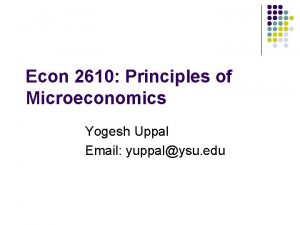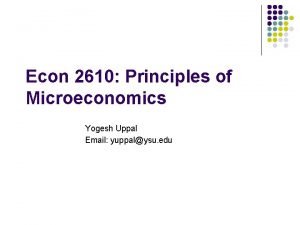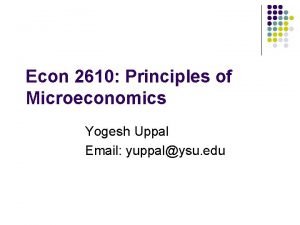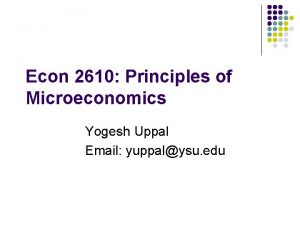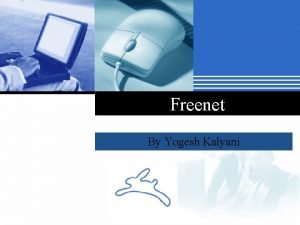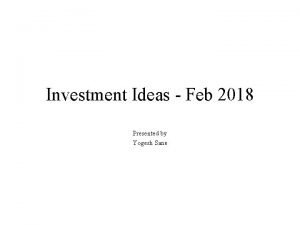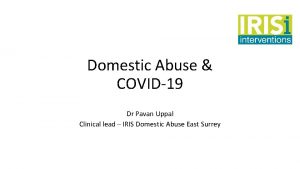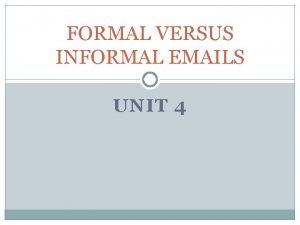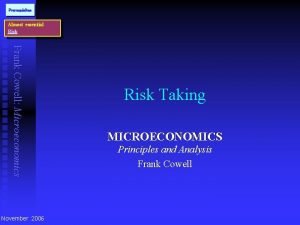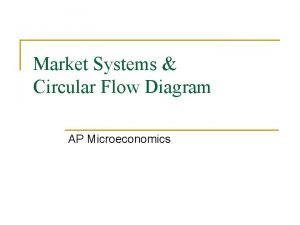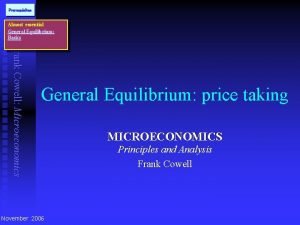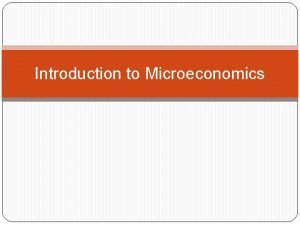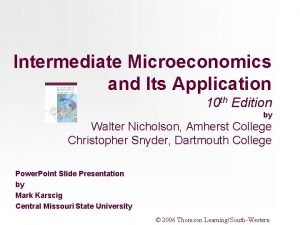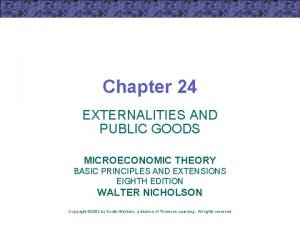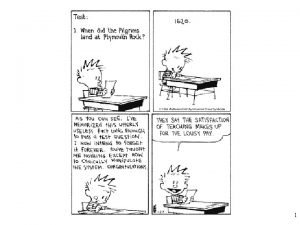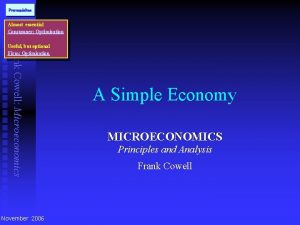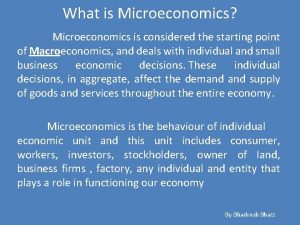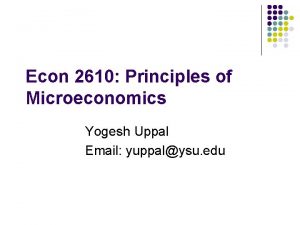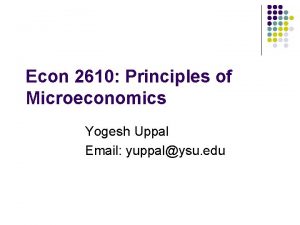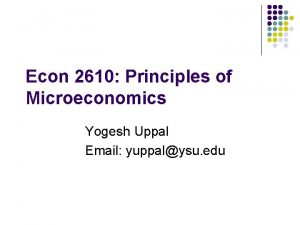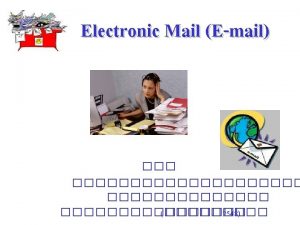Econ 2610 Principles of Microeconomics Yogesh Uppal Email


















- Slides: 18

Econ 2610: Principles of Microeconomics Yogesh Uppal Email: yuppal@ysu. edu

Chapter 8 The Invisible Hand in Action

The Invisible Hand l Individuals act in their own interests l l Aggregate outcome is collective well-being Profit motive l l Produces highly valued goods and services Allocates resources to their highest value use

Accounting Profit l Most common profit idea Accounting profit = total revenue – explicit costs l Explicit costs are payments firms make to purchase l l Resources (labor, land, etc. ) and Products from other firms Easy to compute Easy to compare across firms

Economic Profit l Economic profit is the difference between a firm's total revenue and the sum of its explicit and implicit costs l l l Also called excess profits Implicit costs are the opportunity cost of the resources supplied by the firm's owners Normal profit is the difference between accounting profit and economic profit l Normal profits keep the resources in their current use

Three Kinds of Profit Total Revenue = Explicit Costs + Accounting Profit Total Revenue Explicit Costs Accounting Profit Economic Profit = Accounting Profit – Normal Profit Normal Economic Profit

Economic Profits Guide Decisions l Pudge Buffet's decision: keep farming or quit? l l Quit farming and earn $11, 000 per year working retail Explicit farm costs are $10, 000 Total revenue is $22, 000 Pudge should stick with farming l If revenue fell below $21, 000, Pudge should quit Accounting Profit $12, 000 Economic Profit $1, 000 Normal Profit $11, 000

Owned Inputs l l Rent for the farm land is $6, 000 of the $10, 000 in explicit costs l What changes if Pudge inherits the land? l His rent payments become an implicit cost Pudge should stick with farming Total Revenue $22, 000 Accounting Profit Explicit Costs $4, 000 Economic Profit Implicit Costs $17, 000 Normal Profit $16, 000 $17, 000

Two Functions of Price l l l Rationing function of price distributes scarce goods to the consumers who value them most highly Allocative function of price directs resources away from overcrowded markets to markets that are underserved Invisible Hand Theory is that actions of independent, self-interested buyers and sellers will often result in the most efficient allocation of resource l Articulated by Adam Smith in eighteenth century

Free Entry and Exit l Barrier to entry: any force that prevents firms from entering a new industry l l Legal constraints Practical factors l Free entry and exit is required for the Invisible Hand to work

Response to Economic Profits l Markets with excess profits attract resources Price $/bu Corn Industry S Price $/bu Typical Corn Farm MC ATC Economic Profit 2 2 P 1. 20 D 65 Quantity (M of bushels/year) 130 Quantity (000 s of bushels/year)

Shrinking Economic Profits l Supply increases Price $/bu Corn Industry S S' Price $/bu Typical Corn Farm MC ATC Economic Profit 2 P 1. 50 D 65 95 Quantity (M of bushels/year) 120 130 Quantity (000 s of bushels/year)

Market Equilibrium l Zero economic profits Price $/bu Corn Industry Price $/bu S S' Typical Corn Farm MC ATC S" 2 1. 50 1 D 65 115 Quantity (M of bushels/year) P 90 130 Quantity (000 s of bushels/year)

Economic Losses l Resources leave Price $/bu Corn Industry Price $/bu Typical Corn Farm MC ATC S 0. 75 D 60 Quantity (M of bushels/year) 1. 05 0. 75 P 70 90 Quantity (000 s of bushels/year)

Market Equilibrium l No economic losses Price $/bu S' 1 0. 75 MC ATC S P D 40 60 Quantity (M of bushels/year) 70 90 Quantity (000 s of bushels/year)

Constant-Cost Industry l In the long run, corn costs $1/bu regardless of the size of the industry Price $/bu 1. 00 S MC ATC P D Quantity (M of bushels/year) Quantity (000 s of bushels/year)

Features of the Invisible Hand Benefits of Invisible Hand Cost – Benefit Principle applies § Marginal benefit of last buyer equals marginal cost of last unit produced P = MC § Price paid by buyers is no greater than cost to the seller

Economic Rent l l l Economic profits tend toward zero, yet people get rich Economic rent is the portion of a payment to a factor of production that exceeds the owner's reservation price l People who love their work l Non-reproducible input The case of the talented chef l Unique talent for cooking l In equilibrium, pay the chef to increase in revenue from his talent
 Yogesh uppal
Yogesh uppal Yogesh uppal
Yogesh uppal Polluter
Polluter Yogesh uppal
Yogesh uppal Yogesh kalyani
Yogesh kalyani Yogesh sane
Yogesh sane Pavandeep uppal
Pavandeep uppal 22rents
22rents Format of informal email
Format of informal email Cowell microeconomics
Cowell microeconomics Circular flow diagram menggambarkan
Circular flow diagram menggambarkan Definition of macroeconomics
Definition of macroeconomics Almost essential
Almost essential What is microeconomics
What is microeconomics Uses of microeconomics
Uses of microeconomics Pure public good
Pure public good Unit 1 basic economic concepts
Unit 1 basic economic concepts Cowell microeconomics
Cowell microeconomics What is microeconomics
What is microeconomics
